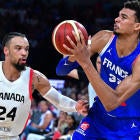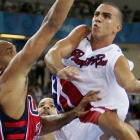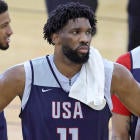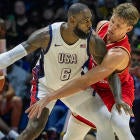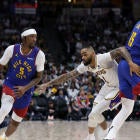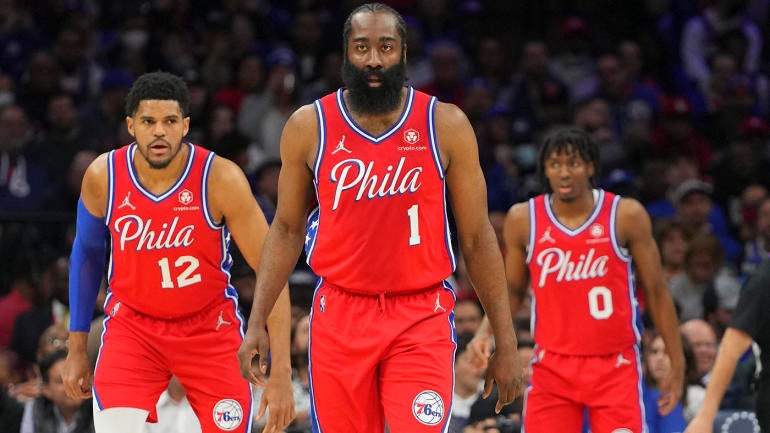
As you might have guessed, James Harden has supercharged the Philadelphia 76ers' starting lineup. In three games, the fivesome of Harden, Tyrese Maxey, Matisse Thybulle, Tobias Harris and Joel Embiid have outscored their opponents 151-110.
Yes, that sample is only 55 minutes against the Minnesota Timberwolves and New York Knicks. But even if the point differential weren't this insane (+34.2 per 100 possessions!), the Harden effect has been obvious. Embiid said after Game 1 that he'd never had such easy shots in his entire career. Maxey is making virtually every shot he takes, and he looks even faster against defenders who are already on their heels.
The beauty of pairing Harden and Embiid, though, is that it also allows the Sixers to separate them. They've been trying to find a solution for their non-Embiid minutes for years, and now, in theory, they can simply play Hardenball: Run everything through him offensively, switch everything defensively.
So far, the results have been mixed. Coach Doc Rivers has staggered Harden and Embiid, and in the 34 minutes that Harden has played without his co-star, Philadelphia has been outscored by two points.
Early in the fourth quarter on Wednesday, the Sixers led the New York Knicks by only six, even though Embiid was +18 in his 29 minutes. It felt familiar, and not in a good way. Then they ran this play:
You can see Harden tell Shake Milton to set a backscreen for Harris, who goes into a post up. This particular screen is called a wedge screen, and the play is called Wedge Punch.
The Knicks' Obi Toppin fronts Harris, and by the time the ball gets to him he's behind the 3-point line with only 10 seconds on the clock. This is not ideal, but Harris drives, kicks it out to Danny Green, sets a ballscreen and short-rolls into a wide-open jumper.
The next time down, it's more wedge action: Milton sets the screen again and Harris pops for a clean 3:
That was the start of a 12-2 run. Ideally, it was also something of a turning point for Harris. He was quiet again in the first three quarters against New York, and Harden's presence has required him to adjust more than anyone else.
With Maxey in for Milton on the next possession, now it's Harden screening for Harris. Toppin is all over Harris' post-up, so the Sixers flow into a pick-and-roll on the second side and Harden finds Maxey, who goes into attack mode:
Philadelphia then runs the same set on the other side and Harris gets the ball where he likes it, thanks to a solid screen from Harden. From there it's an isolation, and Harris draws a foul:
Next possession, there is a twist: Same play, but, instead of posting up, Harris sets a ballscreen for Maxey, who hits college teammate Immanuel Quickley with a Hardenesque stepback 3:
Next one, Harris isolates, backs down Toppin, draws a second defender and kicks it out, which leads to Maxey getting downhill again and drawing a foul.
Then, another twist: They're back on the left side, and Harden fakes the wedge, instead setting the first screen on a double drag:
That was the final possession before Embiid returned, and the only one in this stretch in which Philly didn't score. It did, however, succeed in getting Harris matched up with the smaller Alec Burks in the middle of the floor. If the goal was to get Harris more involved in the offense without straight-up forcing the ball to him, it worked.
"It's a 3-man game," Sixers coach Doc Rivers told reporters. "And that's really all we worked on with that group. And they ran it tonight. I think they got every option. They scored on every option of that one set. So that's good for us."
Also good for Philadelphia is the fact that Harden is enthusiastically screening. The Sixers are not pairing him with a roll man on the second unit -- Rivers indicated that Willie Cauley-Stein would get a shot on Wednesday, but it didn't happen until garbage time -- and they aren't quite giving him pristine, 5-out spacing, either. The Wedge Punch set is dangerous because it has numerous options and involves the three best offensive players on the court. It's notable because it's a microcosm of Philadelphia's larger challenge: Integrating Harden into its preexisting offense.
And to be clear, this play is not new. Here's a variation from last year's playoffs, in which Ben Simmons sets the wedge screen for Harris, then flips it to screen for Seth Curry, leading to an easy duck-in for Embiid:
In a complete reversal from the pre-Harden portion of the season, the Sixers' new second unit has struggled on defense, not offense. With Harden on the court and Embiid off, they've scored 104.5 points per 100 possessions in the halfcourt, per Cleaning The Glass. (For reference, Embiid-without-Harden lineups have scored 102.7 per 100 this season, and the Utah Jazz's league-best halfcourt offense has scored 101 per 100.)
Plenty of questions remain as Philadelphia prepares to face Cleveland, Miami, Chicago and Brooklyn in the next week. I wanted to see Cauley-Stein get a shot (he can switch, too!) and I wonder if Rivers will experiment with centerless lineups, giving Harden a few minutes a game to operate the way he did when PJ Tucker was at the 5 spot. (This seems fun, but it would presumably exacerbate the defensive problems.) Despite a less-than-encouraging stint with the Lakers, DeAndre Jordan is on the way. But the Sixers are already figuring some stuff out.










